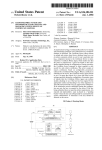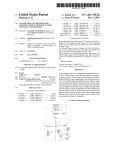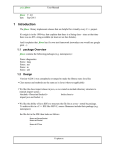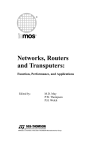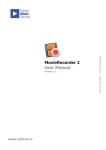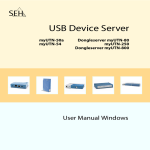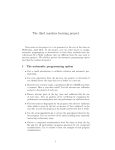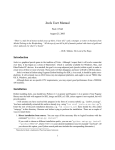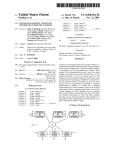Download System and methodology for messaging server
Transcript
US006442686B1
(12)
(54)
United States Patent
(10) Patent N0.:
McArdle et al.
(45) Date of Patent:
US 6,442,686 B1
Aug. 27, 2002
SYSTEM AND METHODOLOGY FOR
5,761,306 A
MESSAGING SERVER-BASED
MANAGEMENT AND ENFORCEMENT OF
5,799,086 A
8/1998 Sudia
2 *
ghgved et al. ........ .. 395/20059
CRYPTO POLICIES
5,850,451 A
:
a
11
(75) Inventors: Mark James McArdle, San Carlos;
1a
12/1998 Sudia
2
gt‘tet‘l’enf ]élZlEUSS°)h°enfeld’ Santa Clam
0
6/1998 Lewis
glfil?detegf 1'
6,067,620 A * 5/2000 Holden 61 a1. ............ .. 713/155
0
6,073,242 A
*
6/2000 Hardy et al. .............. .. 713/201
(73) Assignee: Networks Associates Technology, Inc.,
Santa Clara’ CA (Us)
* Cited by eXaIniner
Primary Examiner—Albert Decady
( * ) Notice:
14782521,” Exam2ner—Pau1FE' cilllaah?nk J S I
Subject to any disclaimer, the term of this
patent is extended or adjusted under 35
(A )S [for
US'C' 154(k)) byo days~
.
gag’ 0; Hlrm
mart,
r1stop er .
(57)
21
( )
(22)
A 1. N0.: 09/157 751
_pp
’
Flledt
Sep- 21, 1998
amc
_J h
' ' nouye’ O n
amaty
ABSTRACT
A cryptographic-enabled messaging system providing a
“PolicY Mana gementAg ent” is described. The Polic Y Man
_
_
agement Agent Works in conjunction With a standard mail
(60)
_ _ Relatul Uis- Apphcatlon Data
PTOVlSlOnal aPPhPatIOH N9; 69/095,422, ?led on Aug 7,
server, such as an SMTP (Simple Mail Transport Protocol)
mail server, to ensure that incoming and outgoing e-mail
82’ alngdggmvlslonal apphcanon NO‘ 6O/O91’649’ ?led on
adheres to the policies that are speci?ed for a given site.
(51)
' ’
'
Int. C].7 ................................................ .. H04L 9/00
Speci?cally, the Agent intercepts e-mail normally bound for
the mail server and checks to make sure that it conforms
(52)
US. Cl. ..................... .. 713/151; 713/153; 713/160;
713/162; 713/164
With policies con?gured for one’s site (e.g., corporate site).
If the e-mail adheres to the policies for the site, it is
(58)
Field of Search ............................... .. 713/151, 152,
forwarded to the mail server Where it is routed to the
713/153, 160, 162, 164
intended recipient. If the e-mail does not adhere to the
policies speci?ed for the site, a message of one’s choosing
56
References Cited
is sent to the client indicatin g that the e-mail Was re'ected.
1
In an exemplary embodiment (e.g., for SMTP), the Policy
US‘ PATENT DOCUMENTS
4,918,728 A
4/1990 Matyas et a1,
5,164,988 A
11/1992 Matyas et al.
5,416,842 A
5/1995
5,436,972 A
7/1995 Flschef
5:495:53 A
2/1996 Lmehan etal-
2
5’745’574 A
Management Agent may be employed to make sure that
e-mail has been encrypted using certain designated recovery
keys; ensure that all e-mail messages are encrypted before
alloWing them to be delivered; specify Whether e-mail must
be signed or not before it is alloWed to pass the policy
requirement; specify Whether conventional encryption is
239mm
alloWed; maintain a log ?le listing all of the attempts to route
4/1998 Mulf?c
5,748,735 A
5/1998 Ganesan
5,751,814 A
5/1998 Kafri
e-mail along With a description of the outcome.
40 Claims, 5 Drawing Sheets
204
KEYBOARD
'_
r
POlNTlNG
205
_
DEVlCE
F
206
202
SCREEN
_
DISPLAY
r 203
207
MAIN
MEMORY
MASS
STORAGE
l/O
CONTROLLER
r.
OUTPUT
DEVICE
201
206
_
I
ENTRAL
PROCESSOR
CACHE
MEMORY
U.S. Patent
Aug. 27, 2002
Sheet 2 0f 5
US 6,442,686 B1
F
KEYBOARD
f.
POINTING
DEVICE
f.
202
SCREEN
DISPLAY
F
MAIN
F
MEMORY
MASS
STORAGE
I/O
CONTROLLER
201
r.
[2
CENTRAL
PROCESSOR
OUTPUT
DEVICE
CACHE
MEMORY
K 209
FIG. 2
U
t
2
.P
m
1
a
B
.
6,
_q
n
2
W83%
_.A
5w
M:2652$
gm.
52%aL
K
H
8m7
S.I0%L
OEEtoaEnsQm
$Em512208131
m..8w86a9m>1o8macz2_>:
Hw2Eanz,5cé9mGa6o
.SEm:952
A
Vmamk
:ak
3Ew>z0amig3ws2z 5>xomlv mazonIwm
%.WEA
“wzozUm
8.0.n
S
8m
"
“w_>._<z
HM,"E@z062Qm5EoZSQ
w“2m..5$3>2o1z4_5>8
AEmE6zolgo
an
_
:3
L- A
1E2.
U.S. Patent
Aug. 27, 2002
Sheet 5 0f 5
f’
US 6,442,686 B1
501
500
INITIALIZE GLOBAL
'—
CONFIGURATION STATE
K- 502
INITIALIZE PROXY
SUBSYSTEM
CAPTURE MESSAGE BODY
K‘
504
PASS MESSAGE BODY TO
PGP SDK FOR ANALYSIS
BUILD STATUS LIST OF:
ENCRYPTIONRECIP/ENTCOUNT
LIST OF ENCRYPTION KEYIDS
CONVENTIONALENCRYPTIONRECIPIENTCOUNT
NUMBER OF SIGNED SECTIONS
NUMBER OF CLEARTEXT SECTIONS
BASED ON THIS INFORMATION, ENFORCE
SPECIFIED CRYPTO POLICIES ON THE MESSAGE:
MESSAGE MUST/MUST NOT/MAY BE ENCRYPTED
MESSAGE MUST/MUST NOT/MAY BE SIGNED
(MUTUALLY EXCLUSIVE WITH PREVIOUS)
IF ENCRYPTED, MESSAGE MUST BE ENCRYPTED TO
ONE OF THE FOLLOWING SETS OF KEYS
IF ENCRYPTED, MESSAGE MUST NOT BE ENCRYPTED
TO ANY OF THE FOLLOWING KEYS
IF ENCRYPTED, CONVENTION ENCRYPTION
MAY/MAY NOT BE USED
K- 507
IF A VIOLATION OCCURS, THE EVENT IS LOGGED
IN THE LOGFILE, AND THE MESSAGE IS NOT
FORWARDED TO THE "REAL" MESSAGING GATEWAY. _-_r@
A CONFIGURABLE MESSAGE, WHICH INFORMS
THE USER WHY HIS MESSAGE WAS REJECTED
IS RETURNED TO THE USER
FIG. 5
US 6,442,686 B1
1
2
SYSTEM AND METHODOLOGY FOR
MESSAGING SERVER-BASED
MANAGEMENT AND ENFORCEMENT OF
CRYPTO POLICIES
any Way compromising the integrity of the private key.
Anyone can use a recipient’s public key to encrypt a
message to that person, With the recipient, in turn, using his
or her oWn corresponding private key to decrypt the mes
sage. One’s private key, on the other hand, is kept secret,
RELATED APPLICATIONS
knoWn only to the user.
Keys are typically stored on “keyrings.” Public keys,
The present application claims the bene?t of priority from
and is related to the following commonly-oWned U.S. pro
visional application: application Ser. No. 60/095,722, ?led
Aug. 7, 1998, and entitled SYSTEM AND METHODOLOGY FOR
including a user’s oWn as Well as those of colleagues’, are
stored in a “public keyring” ?le. Auser’s private key is, in
10
a similar fashion, stored in a “private keyring” ?le. Each key
pair has a User ID (such as the oWner’s name and e-mail
address) so that the user and the user’s colleagues can
MESSAGING SERVER-BASED MANAGEMENT AND ENFORCE
MENT OF CRYPTO POLIcIES; and Ser. No. 60/091,649, ?led
identify the oWners of keys. Each private key also has a
Jul. 2, 1998, and entitled CRYPTOGRAPHIc SYSTEM AND
METHODOLOGY FOR CREATING AND MANAGING CRYPTO 15 passphrase, or verbose passWord, that protects it. No one but
a message’s intended recipient can decrypt the message, not
POLICY ON CERTIFICATE SERVERS. The disclosures of the
even the person Who originally encrypted the message,
foregoing applications are hereby incorporated by reference
because no one else has access to the private key necessary
in their entirety, including any appendices or attachments
thereof, for all purposes.
COPYRIGHT NOTICE
for decrypting the encrypted message.
Since public key cryptography provides privacy Without
20
tional secret key encryption requires, it is commonly
A portion of the disclosure of this patent document
contains material Which is subject to copyright protection.
employed to send secured messages and other documents
from one individual to another across a netWork or other
The copyright oWner has no objection to the facsimile
reproduction by anyone of the patent document or the patent
25
disclosure as it appears in the Patent and Trademark Of?ce
patent ?le or records, but otherWise reserves all copyright
rights Whatsoever.
BACKGROUND OF THE INVENTION
the need for the same kind of secure channels that conven
30
communication channel, including the Internet. An eXample
of its use in a commercial product today includes PGPTM,
available from Pretty Good Privacy, Inc. of Santa Clara.
Calif.
Keys are also used to digitally sign a message or ?le and,
in a complementary manner, to verify a digital signature.
These “digital signatures” alloW authentication of messages.
The present application relates generally to cryptographic
When a user signs a message, a cryptographic program uses
systems and, more particularly, to methods for messaging
server-based management and enforcement of crypto poli
that user’s oWn private key to create a digital signature that
is unique to both the contents of the message and the user’s
cies.
With each passing day, more and more computers are
35
connected together through pervasive open netWorks, such
40
ments in a secured fashion over an open communication
netWork. To this end, some sort of cryptographic system is
Which public and private keys are used When sending and
receiving messages. When keys are used to secure ?les
45 stored on a user’s oWn computer or local netWork server, the
user is both the “sender” (the person Who saves the ?le) and
encryption, a single key is used for both encryption and
decryption. Consider, for eXample, a user (sender) Who
the “recipient” (the person Who opens the ?le).
Cryptographic systems, including ones implementing
public key cryptography, are described in the technical,
Wants to send an electronic mail or “e-mail” message to a
colleague (recipient) in a secured manner, such that no one
Who intercepts the message Will be able to read it. If the
sender employs a cryptographic “secret key” to encrypt the
message, the recipient, in turn, must also use the same key
to decipher or decrypt the message. As a result, the same key
must be initially transmitted via secure channels so that both
parties can knoW it before encrypted messages can be sent
50
55
The deployment of strong cryptography Within an orga
niZation forces some important business policy issues to be
60
or “private key.” Operating in a complementary fashion,
each key in the pair unlocks the code that the other key
makes. Knowing the public key does not help deduce the
corresponding private key, hoWever. Accordingly, the public
Edition, John Wiley & Sons, Inc., 1996. For a description
focusing on the PGPTM implementation of public key
cryptography, see e.g., Gar?nkel, Simon, PGP: Pretty Good
Privacy, O’Reilly & Associates, Inc., 1995. The disclosures
of each of the foregoing are hereby incorporated by refer
ence.
tWo mathematically-related keys, a “public key” and a secret
key can be published and Widely disseminated across a
communications netWork, such as the Internet, Without in
trade, and patent literature. For a general description, see
e.g., Schneier, Bruce, Applied Cryptography, Second
over insecure channels. This is typically inconvenient, hoW
ever. A better approach is, therefore, sought.
Public key cryptography overcomes the problem by elimi
nating the need for a single “secret” key. As illustrated in
FIG. 1A, each user of a public key cryptographic system has
subsequently altered by anyone else. Forgery of a signed
message is computationally infeasible.
By Way of summary, FIG. 1B illustrates the functions for
usually employed.
Generally, cryptographic systems use either “secret-key”
encryption or “public key” encryption. In “secret-key”
to authenticate the signature. Since the signer, alone, pos
sesses the private key that created that signature, authenti
cation of a signature con?rms that the message Was actually
sent by the signer, and that the message has not been
as the Internet, Wide Area NetWorks (WANs), and the like.
With the ever-increasing popularity of such environments
comes the need for exchanging messages and other docu
private key. Any recipient can employ the user’s public key
65
managed. As With all strong crypto, the key(s) to Which the
data is encrypted must be available or else the data is totally
unrecoverable. Most organiZations ?nd this risk unaccept
able. For instance, a company might be (legally) required to
be able to provide copies of e-mail that originated Within its
netWork. Accordingly, most organiZations take steps to
ensure that any corporate information is alWays recoverable
by the company.
US 6,442,686 B1
4
3
(3) conventional encryption recipient count
One Way to accomplish this is to escrow all of the
(conventionalencryptionrecipientcount)
encryption keys Within an organization. This solution has its
oWn disadvantages and policy concerns attendant With other
key escroW approaches. Another method is to employ a
“message recover agent” that is designed to encrypt data to
(4) number of signed sections
Based on the foregoing information, the Policy Manage
a designated recipient (i.e., the user’s company). Encryption
ment Agent may enforce speci?ed crypto policies on the
message. In an exemplary embodiment, policies or rules
client softWare (e.g., PGP) can readily be con?gured to
support this recovery mechanism. HoWever, it is possible for
include:
users to make mistakes, innocent and otherWise. Auser’s act
of doWnloading the freeWare PGP client and running it on a
10
corporate desktop Would undermine the corporate policy, for
(1) message must/must not/may be encrypted
(2) message must/must not/may be signed (mutually
eXclusive With previous)
instance. Enforcement of recovery policies at the client is
aWkWard at best. Hence, a better approach is sought.
(3) if encrypted, message must be encrypted to one of the
Since encrypting e-mail is the most common reason for
(4) if encrypted, message must not be encrypted to any of
organiZations to deploy strong crypto, the messaging gate
folloWing sets of keys
the folloWing keys
15
(5) if encrypted, convention encryption may/may not be
Ways are the most secure point to enforce a corporation’s
crypto policy. It is reasonable to place the enforcement
used
The policies can be applied to certain groups/entities
mechanism at such a point, therefore. What is needed is a
system providing management and enforcement methodolo
based on their netWork location (i.e. Internet Protocol or IP
gies that afford system administrators secure and control
access to the various servers throughout one’s organiZation.
The present invention ful?lls this and other needs.
address).
If a policy violation occurs, the event is logged in a
log?le, and the message is not forWarded to the “real”
SUMMARY OF THE INVENTION
the user Why his message Was rejected, is returned to the
messaging gateWay. Acon?gurable message, Which informs
The present invention comprises a system providing a
25
user. Thereafter, the system may perform cleanup and aWait
another client connection.
“Policy Management Agent” Which Works in conjunction
With a standard mail server, such as an SMTP (Simple Mail
BRIEF DESCRIPTION OF THE DRAWINGS
Transport Protocol) mail server, to ensure that outgoing
FIG. 1A is a block diagram illustrating general public key
(and, optionally, incoming) e-mail adheres to the policies
that are speci?ed for a given site. The Agent intercepts
cryptography technique.
e-mail normally bound for the mail server and checks to
make sure that it conforms With policies con?gured for one’s
and receiving messages.
FIG. 1B is a table summariZing use of keys When sending
site (e.g., corporate site). If the e-mail adheres to the policies
for the site, it is forWarded to the mail server Where it is
routed to the intended recipient. If the e-mail does not adhere
to the policies speci?ed for the site, a message of one’s
choosing is sent to the client indicating that the e-mail Was
35
providing a Policy Management Agent of the present inven
tion.
rejected.
FIG. 4 is a block diagram illustrating basic encryption/
In an exemplary embodiment, the Policy Management
Agent for SMTP provides the folloWing features:
(1) Makes sure that e-mail has been encrypted using
certain designated recovery keys. Only those messages
Which have been encrypted to the required keys are
alloWed to pass through the gateWay.
(2) Ensures that all e-mail messages are encrypted before
alloWing them to be delivered. One can also specify
that e-mail should not be encrypted from certain sites.
(3) Speci?es Whether e-mail must be signed or not before
it is alloWed to pass the policy requirement. The Agent
can also reject e-mail that has been encrypted using
decryption methodology employed by the system of FIG. 3.
FIG. 5 is a How chart illustrating the detailed internal
operation of the Policy Management Agent, operating in
conjunction With other components of the system.
45
GLOSSARY
The folloWing de?nitions are offered for purposes of
illustration, not limitation.
Authentication: The determination of the origin of
encrypted information through the veri?cation of someone’s
digital signature or someone’s public key by checking its
unique ?ngerprint.
certain keys Which are designated as forbidden.
Certify: To sign another person’s public key.
(4) Speci?es Whether conventional encryption is alloWed.
(5) Maintains a log ?le listing all of the attempts to route
e-mail along With a description of the outcome.
In operation, the system initialiZes a global con?guration
state. This step is folloWed by initialiZation of the proXy
FIG. 2 is a block diagram illustrating a computer system
in Which the present invention may be embodied.
FIG. 3 is a block diagram of a messaging system 300
Certifying Authority: One or more trusted individuals are
55
assigned the responsibility of certifying the origin of keys
and adding them to a common database.
Decryption: A method of unscrambling encrypted infor
subsystem (i.e., Agent). NoW the Agent can monitor e-mail:
mation so that it becomes legible again. The recipient’s
the Agent Waits for a client connection. Speci?cally, the
Agent Waits to “capture” a message body. The particular
message body is employed to invoke PGP runtime calls from
the PGPsdk cryptosystem runtime engine (available from
NetWork Associates, Inc.). The PGP runtime engine builds a
private key is used for decryption.
status list for the message, including information about:
(1) encryption recipient count (encryptionrecipientcount)
(2) list of encryption keyids (i.e., key IDs)
Digital Signature: See signature.
Encryption: A method of scrambling information to ren
der it unreadable to anyone eXcept the intended recipient,
Who must decrypt it to read it.
65
Key: A digital code used to encrypt, sign, decrypt and
verify e-mail messages and ?les. Keys come in key pairs and
are stored on keyrings.
US 6,442,686 B1
6
5
Key Escrow: A practice Where a user of a public key
DETAILED DESCRIPTION OF A PREFERRED
EMBODIMENT
encryption system surrenders their private key to a third
party thus permitting them to monitor encrypted communi
The folloWing description Will focus on the presently
preferred embodiment of the present invention, Which is
typically operative in an environment providing application
cations.
Key Fingerprint: Auniquely identifying string of numbers
and characters used to authenticate public keys. For
softWare running under Microsoft® WindoWs, Apple
example, one can telephone the oWner of a public key and
have him or her read the ?ngerprint associated With their key
Macintosh, or Sun Solaris® operating systems. The present
invention, hoWever, is not limited to any particular one
so one can compare it With the ?ngerprint on one’s copy of
their public key to see if they match. If the ?ngerprint does
10
not match, then one knoWs one has a bogus key.
Key ID: Alegible code that uniquely identi?es a key pair.
ety of system and applications. Moreover, the present inven
TWo key pairs may have the same User ID, but they Will
have different Key IDs.
Key Pair: Apublic key and its complimentary private key.
application or any particular environment. Instead, those
skilled in the art Will ?nd that the system and methods of the
present invention may be advantageously applied to a vari
tion may be embodied on a variety of different platforms,
15
In public-key cryptosystems, like the PGP program, each
including UNIX, Linux, NextStep, and the like. Therefore,
the description of the exemplary embodiments that folloWs
is for purposes of illustration and not limitation.
user has at least one key pair.
Keyring: A set of keys. Each user has tWo types of
Messaging Server-based Management and
Enforcement of Crypto Policies
keyrings: a private keyring and a public keyring.
Message Digest: A compact “distillate” of one’s message
A. OvervieW
The present invention comprises a system providing a
or ?le checksum. It represents one’s message, such that if the
message Were altered in any Way, a different message digest
Would be computed from it.
Passphrase: A series of keystrokes that alloW exclusive
“Policy Management Agent” Which Works in conjunction
With a standard mail server, such as an SMTP (Simple Mail
Transport Protocol) mail server, to ensure that outgoing
25
access to one’s private key Which one uses to sign and
that are speci?ed for a given site. The Agent intercepts
decrypt e-mail messages and ?le attachments.
e-mail normally bound for the mail server and checks to
make sure that it conforms With policies con?gured for one’s
Plaintext: Normal, legible, unencrypted, unsigned text.
Private Key: The secret portion of a key pair used to sign
site (e. g., corporate site). If the e-mail adheres to the policies
and decrypt information. Auser’s private key should be kept
for the site, it is forWarded to the mail server Where it is
routed to the intended recipient. If the e-mail does not adhere
to the policies speci?ed for the site, a message of one’s
secret, knoWn only to the user.
Private Keyring: A set of one or more private keys, all of
Which belong to the oWner of the private keyring.
Public Key: One of tWo keys in a key pair used to encrypt
information and verify signatures. Auser’s public key can be
choosing is sent to the client indicating that the e-mail Was
rejected.
35
Widely disseminated to colleagues or strangers. KnoWing a
(1) Makes sure that e-mail has been encrypted using
certain designated recovery keys. Only those messages
Which have been encrypted to the required keys are
alloWed to pass through the gateWay.
(2) Ensures that all e-mail messages are encrypted before
corresponding private key.
Public Keyring: A set of public keys. One’s public keyring
includes one’s oWn public key(s).
Public-Key Cryptography. Cryptography in Which a pub
lic and private key pair is used, and no security is needed in
the channel itself.
45
alloWing them to be delivered. One can also specify
that e-mail should not be encrypted from certain sites.
(3) Speci?es Whether e-mail must be signed or not before
it is alloWed to pass the policy requirement. The Agent
can also reject e-mail that has been encrypted using
cess of signature veri?cation. When one signs a message or
certain keys Which are designated as forbidden.
?le, the PGP program uses one’s private key to create a
(4) Speci?es Whether conventional encryption is alloWed.
digital code that is unique to both the contents of the
message and one’s private key. Anyone can use one’s public
(5) Maintains a log ?le listing all of the attempts to route
e-mail along With a description of the outcome.
Since the system operates in a transparent manner, the
key to verify one’s signature.
SMTP: Simple Mail Transport Protocol—a popular
system appears, from the perspective of a user, as a mes
e-mail protocol, Which is described, for instance, in RFC
821.
In an exemplary embodiment (e.g., for SMTP), the Policy
Management Agent provides the folloWing features:
person’s public key does not help anyone discover the
Sign: To apply a signature.
Signature: A digital code created With a private key.
Signatures alloW authentication of information by the pro
(and, optionally, incoming) e-mail adheres to the policies
saging server (e.g., SMTP server). In actuality, hoWever, the
55
Text: Standard, printable, 7-bit ASCII text.
Trusted: A public key is said to be trusted by the user if
system functions as a proxy, sitting betWeen the messaging
server and the end user. In this manner, When the user sends
a message to another user, the server of the present invention
it has been certi?ed by the user or by someone the user has
designated as an introducer.
can intercept the message and process it before it is actually
posted to the real messaging server.
User ID: A text phrase that identi?es a key pair. For
The Policy Management Agent embodiment for SMTP
example, one common format for a User ID is the oWner’s
serves as a proxy mail server that monitors the port normally
assigned to the SMTP mail server. When a mail client
name and e-mail address. The User ID helps users (both the
oWner and colleagues) identify the oWner of the key pair.
Veri?cation: The act of comparing a signature created
With a private key to its public key. Veri?cation proves that
the information Was actually sent by the signer, and that the
message has not been subsequently altered by anyone else.
generates a “User Agent” (UA) request, the Agent creates a
neW socket and connects to the SMTP server. It then alloWs
65
the transaction to proceed until it encounters an SMTP
“DATA” command indicating that the client is about to send
the data portion of the e-mail message. The Policy Agent
US 6,442,686 B1
7
8
evaluates this information to determine if it contains
encrypted data then, based on the policy established in a
con?guration ?le, decides Whether to send the mail onto the
SMTP server or to reject it and close the connection. When
deliverable. Placing all of the key IDs (e.g., separated by a
blank space) on a single line indicates that the e-mail must
be encrypted to all those keys. If one Wants to specify that
all e-mail must be encrypted by at least one or another key,
then each key ID should be listed on a separate line.
e-mail is rejected for a policy violation, a message (speci?ed
in the con?guration ?le) is output to the client.
forbidkeys <list>
In order to begin using the Policy Management Agent, the
Speci?es the key IDs for those keys that are not alloWed
to be used for encryption purposes.
user redirects e-mail from the standard server and supplies
con?guration details. The folloWing con?guration settings
and their values are eXemplary.
smtphost <IP address> or <server name>
signatures alloW | disalloW require
10
Speci?es the host name of the SMTP mail server currently
installed at one’s site.
conventionalencrypt alloW | disalloW
Speci?es Whether e-mail that uses “conventional encryp
tion” is alloWed to pass through the server. Conventional
smtpport <port number> or <service name>
Speci?es the number of the port Where the SMTP mail
server should listen for mail requests generated by the Policy
Management Agent for SMTP. If one is running the Policy
15
encrypted using “public key encryption” Which is encrypted
With a public key and decrypted With a private key. The
default values is “alloW”.
speci?ed.
recovererror <error message>
agentport <sport number>
Speci?es the error message that is sent to the client When
Speci?es the port Where the Policy Management Agent
Will listen for User Agent (UA) mail requests. This is the
port originally monitored by the SMTP server (generally,
checkhost <IP address> or <host name>
25
AlloWs the user (system administrator) to limit the policy
sage to the required key. recovererror 550 Do it again, and
severe punishment may be forthcoming!
Notice that the standard SMTP 550—parameter is used to
by using Wildcards. For example, 201.010.* or *.pgp.com
Would only act on the speci?ed subnet. This setting is useful
When one does not Want to monitor the Whole address space.
One can list multiple IP addresses on the same line, Where
each is separated by a space, or one can enter a separate
indicate that another line is to folloW and no dash is used on
the ?nal line.
forbiderror <error message>
“checkhost” for each of the addresses.
Speci?es that logging information should be sent to the
system log ?le When this setting is set to true. OtherWise, the
Speci?es the error message that is sent to the client When
35
output is sent to the standard error device (stderr) or a
speci?ed log ?le. The default value for this setting is false.
logging none | error | Warning | info | verbose
folloWing:
none No logging is performed. This is the default value.
as in the previous eXample.
encrypterror <error message>
45
Speci?es the error message that is sent to the client When
a clear teXt message is encountered and encryption is
error Logs all error messages.
required. One may specify that encryption is required
Warning Logs all errors and Warning messages.
through the “mustencrypt” setting. In order to make the
info Logs all errors, Warnings and informational mes
message readable, it should be spread out over several lines
sages.
as in the previous eXample.
verbose Logs all messages.
conventionalencrypterror <error message>
Speci?es the error message that is sent to the client When
log?le <?lename>
Speci?es the name and location of the log ?le used to
record the activity processed by the Agent. By default, the
?le is stored in the folloWing location:
55
/var/adm/messages
eXample.
Indicates Whether all e-mail must be encrypted before
being alloWed to pass through the mail server. Avalue of true
speci?es that all e-mail messages and ?le attachments must
be encrypted, Whereas a value of false speci?es that mes
sages do not need to be encrypted. By default, this option is
set to false. The “recoverykeys” setting, described neXt, lists
all of the keys for Which e-mail must be encrypted.
Speci?es the 64-bit key IDs for all of the entities Who
must be encrypted in order for e-mail to be considered
an attempt is made to send conventionally encrypted email
When this practice is disalloWed by the “conventionalen
crypt” setting. In order to make the message readable, it
should be spread out over several lines as in the previous
mustencrypt true | false
recoverykey <list>
an e-mail message has been encrypted using a forbidden key.
Forbidden keys are de?ned With the “forbidkey” setting. In
order to make the message readable, it should be spread out
over several lines as in the previous eXample.
signatureerror <error message>
Speci?es the error message that is sent to the client When
a signature policy violation occurs. In order to make the
message readable, it should be spread out over several lines
Speci?es the level of information that is recorded in the
log ?le. One can vieW the contents of this ?le to determine
What e-mail requests have been processed by the Agent and
hoW they Were resolved. Options for this setting include the
an e-mail message is not encrypted using a required key
speci?ed With the “encryptkeys” setting. In order to make
the message readable, it should be spread out over several
lines as in the folloWing eXample:
recovererror 550 You have violated corporate policy With
this message recovererror 550 You must encrypt this mes
checking to the mail traf?c coming across a particular subnet
syslog true | false
encryption uses a single cipher that requires a single key to
be decrypted. This is in contrast to e-mail that has been
Management Agent on the same machine as the SMTP
server, then an alternate port other than port 25 should be
port number 25).
Speci?es Whether e-mail should be signed or not. The
default value for this setting is “alloW”.
In operation, the Agent can process the message accord
ing to SMTP protocol, trapping the actual message body.
Once the actual message has been trapped, the Agent can
perform a detailed examination of the message’s encryption
characteristics, including determining Whether the message
is encrypted (and to Whom), Whether it is digitally signed,
65
and the like. Once the Agent has determined the actual
composition of the message and all encryption characteris
tics of interest, the Agent can apply a set of policy rules
Which are con?gurable by the (system administrator) user, as
US 6,442,686 B1
10
per the above con?guration settings. The output from this
by Microsoft® WindoWs NT (Workstation Edition), Which
analysis must conform to the rules in order for the message
to be posted to the actual messaging server.
In the event that the message is non-conforming, the
Agent rejects the message and generates an error dialogue
informing the initiator of the message Why his or her
are available from Microsoft Corporation of Redmond,
Wash. Alternatively, the OS 340 can be provided by IBM
OS/2 (available from IBM Corp. of Armonk, NY.) or
Macintosh OS (available from Apple Computers of
Cupertino, Calif.).
message is being rejected. For example, a message might be
rejected because it Was not encrypted (When corporate
policy required such a message to be encrypted), it Was
encrypted to the Wrong recipient, it Was not encrypted to a
In operation, one or more application programs, such as
client application softWare or “programs” 345 are “loaded”
10
mandatory recipient (e.g., the user’s manager), or the mes
receiving user commands and data. These inputs, in turn,
may be acted upon by the system in accordance With
sage Was not digitally signed by the user. If, on the other
hand, the message conforms to the policy rules, the message
is passed on to the real messaging server, for normal
processing as an outbound e-mail message.
(i.e., transferred from storage 207 into memory 202) for
execution by the system 200. The operating system provides
a WindoWing GUI (graphical user interface) shell 350, for
15
instructions from operating system (OS) module 340, GUI
shell 350, and/or application module(s) 345. The GUI also
In the currently-preferred embodiment, the policy rules
serves to display the results of operation from the OS 340,
are applied to outbound messages. If desired, hoWever, the
rules may also be applied to inbound messages as Well, such
WindoWs shell 350, and application(s) 345, Whereupon the
user may supply additional inputs or terminate the session.
The GUI is typically provided by interaction of the appli
cation modules With the WindoWs shell, both operating
as all messages sent to or received from a particular host that
needed to be encrypted. In such a case, hoWever, the system
is a fairly closed or restrictive system.
under OS 340.
As shoWn, the system 300 includes an e-mail client 325
Accordingly, most corporate sites Would typically prefer
a balanced system that applies policy rules to outbound
having cryptographic capability. An exemplary e-mail client
messages.
may comprise, for instance, Microsoft® Outlook e-mail
B. HardWare suitable for implementation
25
client (available from Microsoft Corp. of Redmond, Wash.)
The present invention may be embodied on one or more
With PGPTM integration (e.g., standalone PGPTM or PGPTM
computer systems, such as the system 200 of FIG. 2, Which
plug-in for Microsoft® Outlook, available from Pretty Good
Privacy, Inc./NetWork Associates, Inc. of Santa Clara,
comprises a central processor 201, a main memory 202, an
input/output controller 203, a keyboard 204, a pointing
device 205 (e.g., mouse, track ball, pen device, or the like),
Calif.), for providing a cryptosystem at the client. This client
cryptosystem, Which is implemented in the commercial
embodiment of PGP for Personal Privacy, Version 5.5 for
a display or screen device 206, and a mass storage 207 (e.g.,
WindoWs 95/NT (available from Pretty Good Privacy, Inc.
of Santa Clara, Calif, at http://WWW.pgp.com), provides
encryption of messages (e.g., e-mail, binary ?les, text
(ASCII) ?les, or the like) for supporting secured communi
hard or ?xed disk, removable ?oppy disk, optical disk,
magneto-optical disk, or ?ash memory). Although not
shoWn separately, a real-time system clock is included With
the system 200, in a conventional manner. Processor 201 35
cation betWeen a sender and a recipient. For a general
includes or is coupled to a cache memory 209 for storing
description of the system, see PGP for Personal Privacy,
Version 5.5 for WindoWs 95/WindoWs NT: User’s Guide
frequently-accessed information; memory 209 may be an
on-chip cache and/or external cache (as shoWn). Avariety of
other input/output device(s) 208, such as a modem, a
(available for Pretty Good Privacy, Inc.). Additionally, the
scanner, a printer, a netWork card, or the like, may be
included in the system 200 in a conventional manner, as
PGP 5.5 User’s Manual is currently available on the Internet
via FTP (File Transfer Protocol) at ftp://ftp.no.pgpi.com/
desired. As shoWn, the various components of the system
pub/pgp/5.5/Win95nt/PGP55Win.pdf. The disclosure of the
200 communicate through a system bus 210 or similar
foregoing is hereby incorporated by reference. For further
architecture. In a preferred embodiment, the system 200
includes an IBM PC-compatible personal computer, avail
able from a variety of vendors (including IBM Corp. of
Armonk,
Typically, one such computer system is
employed as a client machine (e.g., employee’s desktop
45
SYSTEM WITH METHODS FOR USER-CONTROLLED KEY
RECOVERY, by inventor Philip Zimmermann, the entire
disclosure of Which is hereby incorporated by reference.
computer running Microsoft® WindoWs 9x, available from
It is helpful to revieW the basic encryption/decryption
methodology of the client cryptosystem. Because the public
key encryption process is much sloWer than conventional
single-key encryption, the client cryptosystem combines
elements of secret key (symmetric) cryptography With that
Microsoft Corporation of Redmond, Wash.) connected
across a netWork (e.g., 10/100 Base T/Ethernet netWork,
available from 3Com of Santa Clara, Calif.) to a server
computer (e.g., corporate server computer running
of public key (symmetric) cryptography. FIG. 4 illustrates
Microsoft® WindoWs NT, also available from Microsoft
Corporation).
description, see commonly-oWned application Ser. No.
09/090,771, ?led Jun. 4, 1998, entitled CRYPTOGRAPHIC
C. SoftWare architecture
the basic approach. Ahigh-quality, fast, conventional secret
key encryption algorithm is used to encipher the original
Illustrated in FIG. 3, a cryptographic-enabled messaging
system 300 constructed in accordance With the present
unenciphered message or “plaintext” 401. The actual “bulk”
enciphering mechanism employed can be any symmetric
invention comprises at least one client 320 running at a
algorithm, including for instance, CAST (Carlisle Adams
and Stafford Tavares), IDEA (International Data Encryption
55
Workstation, terminal, desktop PC (e.g., system 200), or the
like, Which is connected over a netWork 370 (e.g., 10/100
Base T/Ethernet) to back-end server softWare 380 running
Algorithm), BloW?sh, DES, or DES variants (e.g., such as
on a server computer. The client computer softWare 320,
CRYPT(3), GeneraliZed DES, DES With Alternate S-Boxes,
RDES, S” DES, and DES With Key-Dependent S-Boxes).
See e.g., Bruce Schneier, The IDEA Encryption Algorithm,
Which is stored in system memory 202 and on persistent
storage (e.g., disk memory) 207, includes a kernel or oper
ating system (OS) 340. OS 340 is typically a client OS
provided, for example, by Microsoft® WindoWs 95 or 98, or
triple-DES)), DES With Independent Subkeys, DESX,
65
Dr. Dobb’s Journal, December 1993; Bruce Schneier, The
Blow?sh Encryption Algorithm, Dr. Dobb’s Journal, April
US 6,442,686 B1
11
12
1994, pp. 38—40; and Data Encryption Standard (DES), as
When the user has ?nished creating the encrypted message,
published by the National Bureau of Standards, Department
of Commerce, FIPS, pub 46, January 1977, pp. 653—670.
he or she instructs the e-mail client softWare to “send” the
message to the intended recipient. In response to this
request, the e-mail client softWare attempts to connect to the
For a description of DES variants, see e.g., the abovemen
messaging gateWay, for transporting the e-mail message.
tioned Applied Cryptography by Bruce Schneier. The dis
closures of each of the foregoing are hereby incorporated by
reference. The cryptosystem should generally employ an
The system is con?gured, hoWever, so that the e-mail client
communicates With the Policy Management Agent (i.e.,
proxy server) instead. Speci?cally at this point, therefore,
the Policy Management Agent traps the outbound message
enciphering mechanism stronger than DES, such as CAST
or IDEA.
As part of the foregoing process and in a manner trans
parent to the user, the client cryptosystem generates a
10
temporary random key or “session key” 403 in FIG. 4—a
key Which is valid for the then-current session. In particular,
the session key is used for enciphering the plaintext ?le, for
creating an encrypted message or “ciphertext” 413. Then the
15
recipient’s public key, shoWn as key 405, is used to encipher
this temporary random conventional key, for creating an
encrypted session key 411. The public-key enciphered ses
and processes it according to crypto policy rules Which have
been established for the system (e.g., corporate site). If the
message conforms to the rules, the message may then be
passed on to the messaging gateWay, for transport to the
intended recipient. On the other hand, if the message is
non-conforming, the message is rejected so that it is not
passed on to the messaging gateWay. If desired, the system
may generate user feedback (e.g., error message) and/or an
error log (eg for use by a system administrator).
As also shoWn in FIG. 3, the Policy Management Agent
sion key 403 together With the enciphered text 413 form a
digital envelope 410 that is sent to the recipient. To open the
envelope and retrieve its message, the recipient must furnish
381 includes a Response Component or Engine 383 and an
Analysis Engine 385. Each time a neW message is received,
his or her private key. The recipient does this by selecting his
position of the message, for extracting the message body and
important information about the message. The Analysis
Engine 385 performs the actual processing of the body of the
the Response Component 383 performs parsing and decom
or her private key from a secured keyring, one Which is itself
protected by a passphrase. A corresponding installation of
the cryptosystem at the recipient’s site uses the private key
to decrypt the encrypted session key. Once decrypted, the
session key is used to decrypt the ciphertext, thus regener
25
user message Which has been extracted. For the task of
processing messages, the Analysis Engine receives a global
policy structure. Based on this, the Analysis Engine applies
ating the original message for the recipient. Again, use of a
session key at the recipient end is transparent to the recipient
the policy rules and outputs a result. Based on the result
returned from the Analysis Engine 385, the Response Com
ponent 383 either accepts the message for transport (i.e.,
conforming to the rules) or rejects/blocks it from transport
user.
Referring back to FIG. 3, the back-end server softWare
380 includes a Policy Management Agent (server) 381 and
a messaging gateWay 391, running on a netWork operating
(i.e., non-conforming to the rules). These operations Will
noW be described in further detail.
system 387 (e.g., Microsoft® WindoWs NT). Typically,
D. Internal operation
these are under the control of a system administrator. The 35
Policy Management Agent 381 serves as middleWare or a
operation of the Policy Management Agent, operating in
“proxy” server, in effect sitting betWeen the e-mail client 325
and the messaging gateWay 391.
The messaging gateWay 391 itself simply is the mail
conjunction With other components of the system. At the
outset, the global con?guration state is initialiZed, as indi
cated by step 501. This step is folloWed by initialiZation of
the proxy subsystem (i.e., Agent), as shoWn at step 502. NoW
server Which services the e-mail client. In an exemplary
embodiment, the messaging gateWay 391 comprises an
the Agent can monitor e-mail: the Agent Waits for a client
connection.
Step 503 indicates that the Agent has received or “cap
SMTP server. Both the SMTP protocol and Internet Mail are
Well documented in the technical and trade literature, see
e.g., RFC 821 appended as Appendix A to the abovemen
tioned provisional application 60/095,722 (the disclosure of
45
Which has been incorporated by reference), RFC 822
Further description of PGPsdk is available from Inside the
PGPsdk, version 1.1, Oct. 30, 1997, available from NetWork
Associates, Inc., the entire disclosure of Which is hereby
application 60/095,722 (the disclosure of Which has been
incorporated by reference). The present invention is,
hoWever, protocol independent; thus, the messaging gate
incorporated by reference.
Way to 391 may be constructed to support other messaging
protocols, such as Microsoft® Exchange, Lotus® Notes, or
The PGP runtime engine builds a status list for the
message (step 505), including information about:
other mail transport protocol.
As previously described, the Policy Management Agent
55
325 and the messaging gateWay 391. To achieve this, the
messaging gateWay should only accept connections from the
(3) conventional encryption recipient count
(conventionalencryptionrecipientcount)
ment Agent may enforce speci?ed crypto policies on the
message, as shoWn at step 506. In an exemplary
ment Agent 381, Will reach the messaging gateWay 391.
Although the control may be imposed bi-directionally, the
currently-preferred embodiment adopts the less restrictive
approach of applying controls only to outbound messages.
using the PGP component present at the client machine).
(1) encryption recipient count (encryptionrecipientcount)
(2) list of encryption keyids (i.e., key IDs)
(4) number of signed sections
Based on the foregoing information, the Policy Manage
Policy Management Agent 381 (e.g., determined by exam
ining the IP address of the incoming connection). Only
conforming messages, as determined by the Policy Manage
Use of the system is as folloWs. At the e-mail client, an
end user creates an e-mail message and encrypts it (e.g.,
tured” a message body. The particular message body is
employed to invoke PGP runtime calls from the PGPsdk
cryptosystem (available from NetWork Associates, Inc.).
appended as Appendix B to the abovementioned provisional
381 controls all communication betWeen the e-mail client
FIG. 5 is a How chart illustrating the detailed internal
embodiment, policies or rules include:
65
(1) message must/must not/may be encrypted
(2) message must/must not/may be signed (mutually
exclusive With previous)
(3) if encrypted, message must be encrypted to one of the
folloWing sets of keys
US 6,442,686 B1
14
13
(4) if encrypted, message must not be encrypted to any of
the following keys
-continued
(5) if encrypted, convention encryption may/may not be
used
PGPMessageContent content;
The policies can be applied to certain groups/entities
BOOL conventionalEncryptViolation = FALSE;
BOOL digitalSignatureViolation = FALSE;
BOOL forbiddenKeyViolation = FALSE;
PGPKEYID *keyForbidList = NULL;
PGPKEYID *keyEncList = NULL;
based on their netWork location (i.e. Internet Protocol or IP
address).
As shoWn at step 507, if a policy violation occurs, the
event is logged in a log?le, and the message is not forWarded
to the “real” messaging gateWay. A con?gurable message,
encKeyIdList *currentKeyIdBlock = NULL;
10 uchar **keyIdArray = NULL;
Which informs the user Why his message Was rejected, is
returned to the user. Thereafter, the system may perform
/* Initialize content */
cleanup and aWait another client connection.
E. Source code implementation
The system’s policy may be maintained in a con?guration
?le Which is loaded into a global policy structure, PGP
// sdk context
// housekeeping code omitted for clarity of description
if (DecodePGPMessage( context,
15
pSocket,
buffer,
bu?en,
// socket reference
// buffer containing entire message
// length of buffer
&content )
// structure to contain stats
{
Policy. The structure may be de?ned as folloWs.
/*
* cleanup log error, return
*/
20
typedef struct PGPPolicy {
}
/*
* proxy-speci?c settings
*/
char
unsigned
unsigned
char
unsigned
unsigned
*smtphost;
smtpport;
smtpproxyport;
*pophost;
popport;
popproxyport;
short
short
short
short
return CHECKiGENERALiFAIL
/*
* policy-speci?c settings
*/
/*
* The begining of the “Analysis Engine”
*/
if( policy->alloWConventionalEncrypt == FALSE &&
25
content.conventionalKeyCount > O)
{
/*
* Conventional encryption prohibited
*/
conventionalEncryptViolation = TRUE;
3O
PGPKEYID
* *keyEncList;
PGPKEYID
*keyForbidList;
char
* *checkIP;
unsigned int
unsigned int
unsigned int
mustEncrypt;
alloWConventionalEncrypt;
alloWSigning;
goto done;
}
if( ( ( policy->allowSigning == SIGNiREQUIRE ) &&
( content.signedSectionCount ==
( ( policy->alloWSigning == SIGNiDISALLOW ) &&
( content.signedSectionCount > O ) ) )
35 {
/*
/*
* signing violation
* error message-speci?c settings
*/
char
char
*recoverErrorMessage;
*encryptErrorMessage;
*forbidErrorMessage;
*signatureErrorMessage;
*conventionalEncryptErrorMessage;
char
char
char
digitalSignatureViolation = TRUE;
goto done;
40 3;
* nothing further to check
*/
if( content.encryptionKeyCount == 0)
}
PGPPolicy;
The Agent Waits for a client connection, passing recipient/
protocol speci?c information to the “real” gateWay (e.g.,
goto done;
45 }
/*
* check on keys
*/
SMTP server).
currentKeyIdBlock = content.encryptionKeyIds;
When a message body (“BODY”) is received, the system
/*
proceeds to process the neW message using a ProcessNeW
Message function or method, Which may be implemented as
* Enumerate through the keyids found for all of the
* message blocks in this message, and look for any
* that match the “forbidden keys”
folloWs (e.g., using the Well-knoW C/C++ programming
*/
//
language).
55
housekeeping code omitted for clarity of description
* if We’ve already violated policy then just abort
*/
if( forbiddenKeyViolation == TRUE
//
/*
goto done;
* The proxy component calls this function, once the message body
* has been received (i.e. the DATA state in the SMTP protocol
* has completed)
currentKeyIdBlock = content.encryptionKeyIds;
*/
/*
int
* Enumerate through the keyids found for all of the
ProcessNeWMessage(
* message blocks in this message, and ensure that
* each block has been encrypted to at least 1 set of
PGPContextRef
context,
// sdk context
PGPSOCKETREF
pSocket,
// socket reference
PGPPolicy
*policy,
// policy from cfg ?le
uchar
*buffer,
// buffer containing entire message
ulong
bu?en )
// length of buffer
* the required recovery keys
*/
// housekeeping code omitted for clarity of description
if( recoveryCompliant == FALSE )
US 6,442,686 B1
15
16
-continued
{
/*
/*
* Decodes the buffer passed in, and returns a count of the interesting
* We’ve failed on this buffer
5
*/
break;
* pieces.
*/
int
DecodePGPMessage(
done:
PGPContextRef
/*
* Free up the message keyids
context,
// sdk context
PGPSOCKETREF pSocket,
// socket reference
uchar
*buffer,
// buffer containing entire rnessage
1O
*/
ulong
currentKeyIdBlock = encKeyIdHead;
buflen,
// length of buffer
PGPMessageContent *content ) // structure to contain stats
While( currentKeyIdBlock != NULL)
{
PGPError
keyIdArray = currentKeyIdBlock->keyids;
if( keyIdArray )
err;
PGPAnalyZeContext
15
PGPKeySetRef
analyZeContext;
keyset;
PGPOptionListRef opts = NULL;
for( i = O; keyIdArray[i] != NULL; i++ )
char
errorString[256];.
/*
* Initialize the structure that Will be passed to the callback function
if( keyIdArray[i] )
* from the sdk. This callback function Will alloW us to determine
free( keyIdArray[i] );
2O exactly
* What the sdk has determined in it’s analysis of the buffer
}
*/
free ( keyIdArray );
nextKeyIdBlock = currentKeyIdBlock->next;
free ( currentKeyIdBlock );
analyZeContext.content
analyZeContext.encryptionkeyIdHead
= content->encryptionKeyIds;
currentKeyIdBlock = nextKeyIdBlock;
analyZeContext.keyIdTail
analyZeContext.buffer
25
(void) PGPFreeContext( context );
= content;
= NULL;
= buffer;
analyZeContext.sectionType
PGPsdkCleanup O;
= kPGPAnalyZeiEncrypted;
if( digitalSignatureViolation == TRUE
analyZeContext.header
= FALSE;
analyZeContext.startOffset
/*
= —1;
* Log error, return
30
analyZeContext.endOffset
return( CHECKLSIGNLFAIL );
= 0;
* create a neW keyset, Which is required for use by the sdk during
* a call to PGPDecode
/*
*/
* if there are no conventional recipients, and no encryption keys
* then this message is not encrypted
err = PGPNeWKeySet (context, &keyset);
35 if (IsPGPError (err))
if( ( content.conventionalKeyCount == 0 &&
content.encryptionKeyCount ==
/*
) &&
* Log error, return
( policy->rnustEncrypt == ENCRYPTLREQUIRE ) )
*/
return —1;
/*
}
* Log error, return
40 /*
*/
return( CHECKiENCRYPTiFAIL );
* The buffer is passed to the sdk, along With an event handler,
* Which Will cause the sdk to call the sdkCallback function upon
* each neW event encountered in the buffer
if( conventionalEncryptViolation == TRUE )
{
* We are telling the sdk to pass through all data, and discard
* the output, since We’re not actually trying to decrypt the
45 * message, just get a list of the recipient keyids, and other
/*
* Log error, return
* relevant info.
*/
*/
return( CHECKLCONVENTIONALLFAIL );
err = PGPDecode( context,
PGPOKeySetRef( context, keyset ),
if( forbiddenKeyViolation == TRUE )
PGPOInputBuffer( context, buffer, buflen ),
5O
PGPOEventHandler( context, sdkCallback, &analyZeContext ),
/*
PGPOPassThroughIfUnrecognized( context, TRUE ),
* Log error, return
PGPODiscardOutput( context, TRUE ),
*/
return( CHECKLRECIPIENTLFAIL );
if( recoveryCornpliant == FALSE &&
PGPOLastOption( context ) );
/*
* Clean up the keyset
*/
55
policy->rnustEncrypt == ENCRYPTLREQUIRE )
PGPFreeKeySet ( keyset );
if( IsPGPError( err ) )
/*
* Log error, return
/*
*/
return ( CHECKLRECOVERYLFAIL );
* cleanup, log error, return
6O
*/
return —1;
return ( CHECKLSUCCESS );
}
}
else
{
/*
As shown, the Analysis Engine is invoked by calling 65
DecodePGPMessage. This function may be constructed as
folloWs.
The sdk Was successful m processmg thls buffer’
* Just verify that the last “section” does not contain cleartext
* so We Will look for the “\r\n.\r\n” in the message, Which
US 6,442,686 B1
-continued
-continued
* indicates that We’re done.
*/
*/
case kPGPEventiBeginLeXEvent:
analyZeConteXt.endOffset = buflen — backFromDot;
5
analyZeConteXt = ( PGPAnalyZeConteXt * ) userValue;
return 0;
if( analyzeContext->startOffset != —1 )
}
}
* We should noW only be dealing With situations Where there is
'
~
* a previous buffer
As shown, the function includes a call to PGP Decode, for 10
*/
passing the message BODY to the PGP SDK engine. In
analyzecontgxt'len‘lofselg
particular, the message BODY buffer is passed to the SDK,
_
_
_
_
}
to call an sdkCallback function upon each neW event
else
encountered in the buffer. In effect, the call is telling the 15
i
SDK to pass through all data, and discard the output, since
Set’
_
analyzeContext->startOffset = callBackData->endOffset,
along With an event handler. This action Wlll cause the SDK
_
_ Off
_ event'> ata' egm 6X ata'secnon
1
ff
ana yzecontext'>star.to Set
_
.
_
= event->data.beginLeXData.sectionOffset,
the caller is not actually trying to decrypt the message but,
}
instead, just getting a list of the recipient keyids, and other
break;
relevant info. The sdkCallback function may be implemented as follows
/*
20
_
_
* The kPGPEventiAnalyZeEvent type indicates that the sdk has found
'
* a parsable event. We’re looking here for signed blocks.
*/
case kPGPEventiAnalyZeEvent:
analyZeConteXt
/*
* SDK Decoding callback, Where We Will react to the interesting events
* Which occur during PGPDecode
= ( PGPAnalyZeConteXt * ) userValue;
analyZeConteXt—>type = event->data.analyZeData.sectionType;
if( event->data.analyZeData.sectionType == kPGPAnalyZeiSigned )
25
*/
analyzeContext->content.signedSectionCount++;
PGPError
sdkCallback(
break;
PGPConteXtRef conteXt,
PGPEvent *event,
return kPGPErroriNoErr;
PGPUserValue userValue)
3O }
{
const PGPKeyID
*keyIDArray;
'
'
PGPError
err = kPGPErroriNoErr;
PGPUIM32
$011M;
if the message is policy compliant. The program logic,
PGPUIHQZ
1;
Which is shoWn above for the ProcessNeWMessage API call,
PGPAnalyZeConteXt
-
encKeyIdList
enCKeyIdList
char
M
*analyZeConteXt;
.
The Response Component or Engine may noW determine
35
keyIdHead,
-
f
*keyIdTa?;
-
may be summarized by the folloWing pseudo-code.
.
1
.
.
.
I >1 conventiona encryption recipient
keyIDBuffer[kPGPMaXKeyIDStringSize];
AND COIlteIltlOn encryption 1S FORBIDDEN
SWitCh( event->type)
Log conventional encryption violation
{
Reject error With appropriate message
* The kPGPEventiRecipientsEvent type indicates that the sdk has
40
* found one or more encryption recipients in the current buffer
I/Segment
If digital signatures REQUIRED and signature count==
case kPGPEventiRecipientsEvent:
Log slgnature Ylolanon '
analyZeConteXt = ( PGPAnalyZeConteXt * ) userValue;
ffunt
= event‘>data-reC1P1entSDatakeycount;
Reject error With appropriate message
45
If digital signatures FORBIDDEN and signature count >0
* stored in a super-list. We do this to ensure that all
Log signature violation
* encrypted blocks are policy compliant.
* Add this keyids in this block to the tail of the “super-list”
Reject error With appropriate message
550 You have signed this message, and you must not sign
email.
If encryption is REQUIRED and the message is NOT
housekeeping code omitted for clarity of description
* We Will also increment the conventional encryption key
* count.
encrypted
*/
analyzeContext->content.conventionalKeyCount +=
event->data.recipientsData.conventionalPassphraseCount;
55
Log encryption violation
60
Reject error With appropriate message
SSO-You have sent this message in clearteXt,
SSO-and all email must be encrypted.
550 The message has been rejected
If message is encrypted to a FORBIDDEN key
keyIDArray = event->data.recipientsData.keyIDArray;
/*
*
*
*
*
the keyIDArray contains the internal keyids. We Will use
this information to retrieve human-readable, string versions
of the keyids, so We can match With the versions in the policy
policyuration file
*/
//
housekeeping code omitted for clarity
analyzeContext->content.encryptionKeyCount += count;
return kPGPErroriNoErr;
/*
* The kPGPEventiBeginLeXEvent type indicates that the sdk has
* found the start of a neW section
550 You have not signed this message, and messages must
be signed.
* The list of keyids for each encryption block section is
//
/*
‘550 You have convennonany encrypted thls message' It 15
I‘GJCCIGd
Log encryption violation
Reject error With appropriate message
SSO-You have encrypted this message to one or more
forbidden
550 key. The message has been rejected.
If message is NOT encrypted to one of the sets of recovery
keys
US 6,442,686 B1
19
20
Log encryption violation
7. The method of claim 1, Wherein said set of constraints
includes a constraint specifying that if a particular message
Reject error With appropriate message
550-You have violated corporate policy With this message
550-You must also encrypt this message to the corporate
is encrypted, the message must be encrypted to one of a set
of designated keys.
key
8. The method of claim 1, Wherein said set of constraints
550 The message has been REJECTED.
includes a constraint specifying Whether a particular mes
If message is policy compliant
ForWard message body to “real” messaging gateWay and
particular key.
sage must be rejected if it has been encrypted With a
9. The method of claim 8, Wherein said particular key is
continue transaction
NoW, the system may perform cleanup and aWait another
10
client connection.
Also appended as Appendix C to the abovementioned
encryption is alloWed.
provisional application 60/095,722 (the disclosure of Which
11. The method of claim 1, Wherein said set of constraints
has been incorporated by reference) is user documentation
entitled, Pretty Good PrivacyTM Policy Management Agent
15
For SMTP For UNIX/Windows NT, Which provides further
description of the present invention.
While the invention is described in some detail With
speci?c reference to a single-preferred embodiment and
certain alternatives, there is no intent to limit the invention
to that particular embodiment or those speci?c alternatives.
Thus, the true scope of the present invention is not limited
to any one of the foregoing exemplary embodiments but is
is speci?ed by a con?guration ?le.
12. The method of claim 11, Wherein said con?guration
?le is con?gurable only by a user having system adminis
trator privileges.
13. The method of claim 1, further comprising:
generating an error message for a message that has been
rejected.
instead de?ned by the appended claims.
What is claimed is:
1. In a computer environment having a messaging service
designated as a forbidden key.
10. The method of claim 1, Wherein said set of constraints
includes a constraint specifying Whether conventional
25
14. The method of claim 1, Wherein said set of constraints
includes a constraint specifying that if a particular message
is encrypted, the message must not be encrypted to any one
of a set of designated keys.
15. The method of claim 11, Wherein said crypto policy is
applied to certain clients based on their netWork location.
16. The method of claim 15, Wherein said netWork loca
for transmitting messages created by clients having public
key cryptographic support, a method for managing a crypto
policy for messages submitted for transmission by the
tions comprise Internet Protocol (IP) addresses.
17. The method of claim 1, further comprising:
messaging service, the method comprising:
de?ning a crypto policy comprising a set of constraints
logging an entry to a log ?le for indicating that a particular
specifying one or more conditions Which messages
message has been rejected.
18. The method of claim 1, Wherein said step of receiving
a particular message comprises:
submitted to the messaging service must satisfy before
being accepted for transmission by the messaging ser
vice;
35
receiving a particular message from a client for transmis
sion by the messaging service;
ing a particular message further comprises:
determining Whether the particular message conforms to
the crypto policy by applying said set of constraints to
capturing the particular message’s message body.
20. The method of claim 1, Wherein said determining step
the message;
comprises:
if the particular message satis?es said set of constraints,
forWarding the particular message to the messaging
parsing the message body for gathering information about
service, so that the message may be transmitted to its
intended recipient; and
it.
45
if the particular message does not satisfy said set of
constraints, rejecting the particular message, so that the
message is blocked from transmission by the messag
messages received at a mail server from a plurality of
de?ning a set of constraints specifying one or more
conditions Which messages must satisfy before being
accepted for transmission to intended recipients;
2. The method of claim 1, Wherein said messaging service
comprises a messaging service compatible With Simple Mail
intercepting a request to transmit a particular message
before the request is provided to the mail server;
Transport Protocol (SMTP).
3. The method of claim 1, Wherein said set of constraints
includes a constraint specifying Whether a particular mes
sage must be encrypted, must not be encrypted, or may be 55
encrypted.
automatically applying said set of constraints for deter
mining Whether the particular message should be
passed to the mail server for transmission to intended
recipient; and
4. The method of claim 1, Wherein said set of constraints
if the particular message satis?es said set of constraints,
includes a constraint specifying Whether a particular mes
sage must be encrypted using at least one designated recov
forWarding the particular message to the mail server so
that the particular message may be transmitted to its
ery key.
intended recipients.
5. The method of claim 1, Wherein said set of constraints
22. The method of claim 21, further comprising:
if the particular message does not satisfy said set of
includes a constraint specifying Whether a particular mes
sage may not be encrypted from certain sites.
6. The method of claim 1, Wherein said set of constraints
sage must be digitally signed, must not be digitally signed,
or may be digitally signed.
21. A method for managing transmission of encrypted
clients, the method comprising:
ing service.
includes a constraint specifying Whether a particular mes
providing a proXy for effecting communications betWeen
clients and the messaging service.
19. The method of claim 18, Wherein said step of receiv
constraints, rejecting the message.
65
23. The method of claim 21, further comprising:
displaying an error message indicating Why the message
has been rejected.
US 6,442,686 B1
21
22
24. The method of claim 21, wherein said mail server is
server, for forWarding the particular message to the
mail server only if the particular message satis?es said
compatible With Simple Mail Transport Protocol (SMTP).
policy.
25. The method of claim 21, Wherein said set of con
straints includes a constraint specifying Whether a particular
message must be encrypted, must not be encrypted, or may
32. The system of claim 31, Wherein said agent rejects the
particular message if the message does not satisfy said
be encrypted.
policy.
26. The method of claim 21, Wherein said set of con
straints includes a constraint specifying Whether a particular
33. The system of claim 31, Wherein said agent optionally
returns an error message indicating Why the message has
message must be encrypted using at least one designated
recovery key.
27. The method of claim 21, Wherein said set of con
straints includes a constraint specifying Whether a particular
message may not be encrypted from certain sites.
28. The method of claim 21, Wherein said set of con
straints includes a constraint specifying Whether a particular
been rejected.
10
encrypted, must not be encrypted, or may be encrypted.
35. The system of claim 31, Wherein said policy includes
15
a condition specifying Whether a particular message may not
29. The method of claim 21, Wherein said set of con
straints includes a constraint specifying that if a particular
message is encrypted, the message must be encrypted to one
of a set of designated keys.
30. The method of claim 21, Wherein said set of con
straints includes a constraint specifying Whether a particular
message must be rejected if it has been encrypted With a
31. A system for managing transmission of encrypted
messages received at a mail server from a plurality of
clients, the system comprising:
a con?guration setting de?ning a policy specifying one or
more conditions Which message must satisfy before
being accepted for transmission to intended recipients;
and
an agent, responsive to a request to transmit a particular
message before the request is provided to the mail
a condition specifying Whether a particular message must be
encrypted using at least one designated recovery key.
36. The system of claim 31, Wherein said policy includes
message must be digitally signed, must not be digitally
signed, or may be digitally signed.
particular key.
34. The system of claim 31, Wherein said policy includes
a condition specifying Whether a particular message must be
be encrypted from certain sites.
37. The system of claim 31, Wherein said policy includes
a condition specifying Whether a particular message must be
digitally signed, must not be digitally signed, or may be
digitally signed.
38. The system of claim 31, Wherein said policy includes
25
a condition specifying that if a particular message is
encrypted, the message must be encrypted to one of a set of
designated keys.
39. The system of claim 31, Wherein said policy includes
a condition specifying Whether a particular message must be
rejected if it has been encrypted With a particular key.
40. The system of claim 31, Wherein said particular key is
designated as a forbidden key.
*
*
*
*
*

















